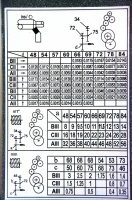I've built a couple of these spreadsheets. For an House of Tools 12x36 and for a Colchester 14x40 clone. In both cases, I came up with a few threading possibilities that were not documented for the machine, or which were close enough that it did not matter. i.e. an error of 0.001" in 10" will never matter in a real thread. Even an error of 0.001" in 1" is probably usable.
The key to calculating the threading possibilities is to determine how many times the lead-screw turns for each rotation of the chuck for every possible combination of gears. Then multiply that by the pitch of the lead-screw.
For figuring out the feed possibilities, you need to know what is happening inside the carriage as well, but that is usually not as interesting, except to verify the feed charts.
For instance, if the lead-screw has a 1/8" pitch (8 threads per inch), and it turns once for every rotation of the chuck (1:1), the carriage will advance 1/8" for every turn of the chuck, so it will do 8 TPI.
If the ratio is 1/2 turn of the lead-screw for every rotation of the chuck (2:1), it will be 16TPI.
With the HOT lathe, I put a turns counter in the chuck and at the end of the lead-screw and then ran the lathe for a couple of hundred chuck rotations for each combination of the selectable internal gears. That got me the final ratio and with a bit of head scratching, I figured out what each lever did. For one lever, the ratio was 2:1 between the H and L settings, so that was easy. There were some 3:2's and 4:5's, and I think a 3:7 or something like that. From that I figured out what the internal gear ratios were and filled out the spreadsheet for all the possible external gear configurations.
Remember, it doesn't matter if the gears are 18:36 or 17:34, they are both 1:2.
An idler gear does not matter, since if you have 18:36, and then 36:40, that is the same as 18:40, since the two 36's on the idler gear cancel out. The idler gear just changes direction in that case.
With the "Colchester", I had it apart anyway, so I counted the teeth on all the gears, so I didn't have to guess at the internal ratios.
Metric / imperial changeover is usually done with external (and sometimes with an internal gear) of 127:100 or something similar. They key is the 127 teeth. That works because 1" = (exactly by definition) 254mm. 254/2 = 127.
The Colchester and similar feed gearboxes (identified because they have four levers: ABC, DEF, WXYZ, and 1-8), are very cool using multiple power flow paths internally, but the result is that they do an approximate metric-imperial conversion, good to around 0.001" in 10". Once the patent ran out on that design, I think many lathe manufacturers stole the design, since it supports pretty much everything you would want to do on a lathe without any external gear changes. I'd bet any feed gearbox with three levers on the top with 3, 3, and 4 selections, and one at the bottom with 8 positions is effectively identical.
I have posted my HOT spreadsheet in the past. If you have come across it, it may seem very complex, because I used a Visual Basic function to do the math to make the spreadsheet a bit simpler, but I'm a software development kinda guy, so I think that is simpler, many people might not.
Did I make the situation better or worse for you?

